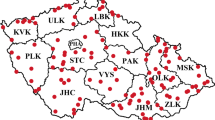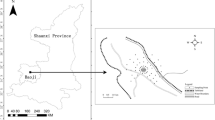Abstract
Purpose
The heavy metal lead (Pb) is toxic to living organisms. Forest soils are important sinks for heavy metals generated by human activities. The forest at Dinghushan of southern China has experienced long-term exposure to atmospheric pollutants from the Pearl River Delta (PRD). The objectives of this research were (a) to determine the vertical and temporal distribution of Pb in the forest soil at Dinghushan, (b) to determine whether dilute acid extraction could be used to identify anthropogenic sources of Pb in forest soil, and (c) to determine the main anthropogenic contributors to soil Pb.
Materials and methods
Lead concentrations and isotopes were measured in two sets of forest soil samples. One set consisted of archived samples from 0 to 20 cm depth collected annually from 1997 to 2010. The other set was collected throughout three profiles sampled at 5-cm intervals to the bedrock (85 cm depth) in 2011. The soil samples were air-dried, ground, and passed through a 100-mesh polyethylene sieve. Lead in the samples was digested with concentrated acid (HNO3 + HClO4, 4:1 v/v) or extracted with dilute acid (1 M HCl with a soil/solution ratio of 1:10) and was measured with an inductively coupled plasma mass spectrometer.
Results and discussion
Concentrations of Pb obtained both by total digestion and dilute acid extraction decreased with soil depth in the profile samples and increased over time in the archived ones. Soils at 0–20 cm depth had Pb concentrations of more than twice of the local soil background value. In all soil samples, the 206/207Pb ratios was lower and the 206/204Pb, 207/204Pb, and 208/204Pb ratios were higher with the dilute acid extraction than with the strong-acid digestion, indicating that dilute acid extraction could be used to distinguish between anthropogenic and geogenic Pb. Comparison of the Pb isotope ratios in the samples with those in the main pollutants from the PRD indicated that coal combustion and industrial emission were the main contributors to the forest soil Pb at Dinghushan.
Conclusions
The forest soil (0–20 cm depth) at Dinghushan was contaminated by Pb. Dilute acid extraction could be used to identify anthropogenic Pb sources. From 1997 to 2010, the main contributors of anthropogenic Pb to the forest soil at Dinghushan were coal combustion and industrial emission. Measures that control Pb emission from coal combustion and industrial activity, changes in coal consumption, and re-adjustments of industry development in the PRD should reduce Pb contamination of forest soil.






Similar content being viewed by others
References
ATSDR (Agency for Toxic Substances and Disease Registry) (2007) Toxicological profile for lead. Department of Health and Human Services, Public Health Service, Atlanta
CNEMC (China National Environmental Monitoring Centre) (1990) Background values of soil elements in China. China Environmental Science, Beijing (in Chinese)
Duzgoren-Aydin NS, Wong CS, Aydin A, Song Z, You M (2006) Heavy metal contamination and distribution of Guangzhou, SE China. Environ Geochem Hlth 28:375–391
Emmanuel S, Erel Y (2002) Implications from concentrations and isotopic data for Pb partitioning processes in soils. Geochim Cosmochim Ac 66:2517–2527
Ettler V, Mihaljevič M, Sebek O, Molek M, Grygar T, Zeman J (2006) Geocheimcal and Pb isotopic evidence for sources and dispersal of metal contamination in stream sediments from the mining and smelting district of Pribram, Czech Republic. Environ Pollut 142:409–417
Ettler V, Vanek A, Mihaljevič M, Bezdicka P (2005) Contrasting lead speciation in forest and tilled soils heavily polluted by lead metallurgy. Chemosphere 58:1449–1459
Fang YT, Yoh M, Koba K, Zhu WX, Takebayashi Y, Xiao YH, Lei CY, Mo JM, Zhang W, Lu XK (2011) Nitrogen deposition and forest nitrogen cycling along an urban–rural transect in southern China. Glob Change Biol 17:872–885
Fang YT, Zhu WX, Mo JM, Zhou GY, Gundersen P (2006) Dynamics of soil inorganic nitrogen and their responses to nitrogen additions in three subtropical forests, south China. J Environ Sci 18:752–759
Farmer JG, Graham MC, Bacon JR, Dunn SM, Vinagradoff SI, MacKenzie AB (2005) Isotopic characterisation of the historical lead deposition record at Glensaugh, an organic rich, upland catchment in rural N.E. Scotland. Sci Total Environ 346:121–137
Fernandez C, Monna F, Labanowski J, Loubet M, van Oort F (2008) Anthropogenic lead distribution in soils under arable land and permanent grassland estimated by Pb isotopic compositions. Environ Pollut 156:1083–1091
Guangdong Provincial Statistical Bureau (2003) Guangdong statistical yearbook. Chinese Statistical, Beijing (in Chinese)
Haack UK, Heinrichs H, Gutsche FH, Plessow K (2003) The isotopic composition of anthropogenic Pb in soil profiles of Northern Germany: evidence for pollutant Pb from a continent-wide mixing system. Water Air Soil Poll 150:113–134
Hansmann W, Köppel V (2000) Lead-isotopes as tracer of pollutants in soils. Chem Geol 171:123–144
He CH, Chen SQ, Liang YA (1982) The soil of Dinghushan biosphere reserve. Trop Subtrop For Ecosyst 1:25–38
Hernandez L, Probst A, Probst JL, Ulrich E (2003) Heavy metal distribution in some French forest soils: evidence for atmospheric contamination. Sci Total Environ 312:195–219
Hosono T, Su CC, Okamura K, Taniguchi M (2010) Historical record of heavy metal pollution deduced by lead isotope ratios in core sediments from the Osaka Bay, Japan. J Geochem Explor 107:1–8
Hou X, Parent M, Savard MM, Tasse N, Begin C, Marion J (2006) Lead concentrations and isotope ratios in the exchangeable fraction: tracing soil contamination near a copper smelter. Geochem Explor Environ Anal 6:229–236
Huang ZL, Ding MM, Zhang ZP, Yi WM (1994) The hydrological processes and nitrogen dynamics in a monsoon evergreen broadleaved forest of Dinghushan. Acta Phytoecologica Sin 8:194–199 (in Chinese with English abstract)
Ito S, Yokoyama T, Asakura K (2006) Emissions of mercury and other trace elements from coal-fired power plants in Japan. Sci Total Environ 368:397–402
Khan S, Cao Q, Zheng YM, Huang YZ, Zhu YG (2008) Health risks of heavy metals in contaminated soils and food crops irrigated with wastewater in Beijing, China. Environ Pollut 152:686–692
Kirpichtchikova TA, Manceau A, Spadini L, Panfili F, Marcus MA, Jacquet T (2006) Speciation and solubility of heavy metals in contaminated soil using X-ray microfluorescence, EXAFS spectroscopy, chemical extraction, and thermodynamic modeling. Geochim Cosmochim Ac 70:2163–2190
Klaminder J, Bindler R, Emteryd O, Renberg I (2005) Uptake and recycling of lead by boreal forest plants: quantitative estimates from a site in northern Sweden. Geochim Cosmochim Ac 69:2485–2496
Komárek M, Ettler V, Chrastny V, Mihaljevic M (2008) Lead isotopes in environmental sciences: a review. Environ Int 34:562–577
Lee CS, Li XD, Shi WZ, Cheung SC, Thornton I (2006) Metal contamination in urban, suburban, and country park soils of Hong Kong: a study based on GIS and multivariate statistics. Sci Total Environ 356:45–61
Li HB, Yu S, Li GL, Deng H, Luo XS (2011) Contamination and source differentiation of Pb in the park soils along an urban–rural gradient in Shanghai. Environ Pollut 159:3536–3544
Li XD, Wai OWH, Li YS, Coles BJ, Ramsey H, Thornton I (2000) Heavy metal distribution in sediments profiles of the Pearl River estuary, South China. Appl Geochem 15:567–581
Luo XS, Yu S, Li XD (2011) Distribution, availability, and sources of trace metals in different particle size fractions of urban soils in Hong Kong: implications for assessing the risk to human health. Environ Pollut 159:1317–1326
Marchand C, Allenbach M, Lallier-vergès E (2011) Relationships between heavy metals distribution and organic matter cycling in mangrove sediments (Conception Bay, New Caledonia). Geoderma 160:444–456
Monna F, Hamer K, Lévêque J, Sauer M (2000) Pb isotopes as a reliable marker of early mining and smelting in the Northern Harz province (Lower Saxony, Germany). J Geochem Explor 68:201–210
Monna F, Lancelot J, Croudace IW, Cundy AB, Lewis JT (1997) Pb isotopic composition of airborne particulate material from France and the Southern United Kingdom: implications for Pb pollution sources in urban areas. Environ Sci Technol 31:2277–2286
Nriagu JO (1990) The rise and fall of leaded gasoline. Sci Total Environ 92:13–28
Qi SH, Sheng GY, Fu JM, Ye ZX, Wu JX (2001) PAHs in aerosols at Dinghushan natural protection zone. J China Univ Geosci 26:85–87 (in Chinese, with English abstract)
Salmi T, Määttä A, Anttila P, Ruoho-Airola T, Amnell T (2002) Detection trends of annual values of atmospheric pollutants by the Mann–Kendall test and Sen’s slope estimates—the excel template application MAKESENS. Finish Meteorological Institute, Helsinki
Snape I, Scouller RC, Stark SC, Stark J, Riddle MJ, Gore DB (2004) Characterisation of the dilute HCl extraction method for the identification of metal contamination in Antarctic marine sediments. Chemosphere 57:491–504
Su WS, Ye ZH, Zhang ZQ, Wong MH, Lan CY (2003) Restoration of lead and zinc mine tailings in southern China. Acta Ecologica Sinica 23:1629–1639 (in Chinese with English abstract)
Teutsch N, Erel Y, Halicz L, Banin A (2001) Distribution of natural and anthropogenic lead in Mediterranean soils. Geochim Cosmochim Ac 65:2853–2864
Townsend AT, Snape I, Palmer AS, Seen AJ (2009) Lead isotopic signatures in Antarctic marine sediment cores: a comparison between 1 M HCl partial extraction and HF total digestion pre-treatments for discerning anthropogenic inputs. Sci Total Environ 408:382–389
van Oort F, Jongmans AG, Citeau L, Lamy I, Chevallier P (2006) Microscale Zn and Pb distribution patterns in subsurface soil horizons: an indication for metal transport dynamics. Eur J Soil Sci 57:154–166
Watmough SA, Hutchinson TC (2004) The quantification and distribution of pollution Pb at a woodland in rural south central Ontario, Canada. Environ Pollut 128:419–428
Watmough SA, Hutchinson TC, Dillon PJ (2004) Lead dynamics in the forest floor and mineral soil in south-central Ontario. Biogeochemistry 71:43–68
Wong CS, Li XD (2004) Pb contamination and isotopic composition of urban soils in Hong Kong. Sci Total Environ 319:185–195
Wong SC, Li XD, Zhang G, Qi SH, Min YS (2002) Heavy metals in agricultural soils of the Pearl River Delta, south China. Environ Pollut 119:33–44
Wuana RA, Okieimen FE (2011) Heavy metals in contaminated soils: a review of sources, chemistry, risks and best available strategies for remediation. ISRN Ecol 2011:1–20
Zhang QM (2011) Collection of site-based observation and research for CERN, Forest volume, Dinghushan Site in Guangdong Province (1998–2008). In: Sun HL (ed) Data set of long-term location observation and research, Chinese Ecosystem Research Network. China Agriculture, Beijing, pp 91–94 (in Chinese)
Zheng J, Tan M, Shibata Y, Tanaka A, Li Y, Zhang G, Zhang Y, Shan Z (2004) Characteristics of lead isotope ratios and elemental concentrations in PM10 fraction of airborne particulate matter in Shanghai after the phase-out of leaded gasoline. Atmos Environ 38:1191–1200
Zhu BQ (1995) The mapping of geochemical provinces in China based on Pb isotopes. J Geochem Explor 55:171–181
Zhu BQ, Chang XY, Qiu HN, Sun DZ (1998) Characteristics of Proterozoic basements on the geochemical steep zones in the continent of China and their implications for setting of super large deposits. Sci China Ser D 41(Suppl):54–64
Zhu BQ, Chen YW, Peng JH (2001) Lead isotope geochemistry of the urban environment in the Pearl River Delta. Appl Geochem 16:409–417
Zhu BQ, Wang HF, Mao CX, Zhu NJ, Huang RS, Peng JH, Pu ZP (1989) Geochronology of and Nd–Sr–Pb isotopic evidence for Mantle source in the ancient subduction zone beneath Sanshui Basin, Guangdong province, China. Chinese J Geochem 8:65–71
Acknowledgments
This project has been jointly supported by the National Natural Science Foundation of China (nos. 30972365, 31170427) and the Knowledge Innovation Program of the Chinese Academy of Sciences (no. KSCX2-EW-J-28). The authors wish to thank Dr. QQ Chi and Dr. HB Li for their great assistance in isotope measurement at the Institute of Urban Environment, CAS.
Author information
Authors and Affiliations
Corresponding author
Additional information
Responsible editor: Willie Peijnenburg
Rights and permissions
About this article
Cite this article
Kuang, Y., Zhu, X., Xi, D. et al. Distribution of anthropogenic lead estimated by Pb isotopic composition in the upper layers of soil from a mixed forest at Dinghushan, southern China. J Soils Sediments 13, 394–402 (2013). https://doi.org/10.1007/s11368-012-0634-6
Received:
Accepted:
Published:
Issue Date:
DOI: https://doi.org/10.1007/s11368-012-0634-6




